
Tet in old Ha Noi
Latest
| TIN LIÊN QUAN | |
| Alleyway murals of Central Da Nang City | |
| Vietnamese communities abroad celebrate Tet | |
A spring drizzle falls on pink peach blossoms and the white petals of apricot flowers. The children relish the foretaste of the joys of Tet. They will wear new clothes and eat as much as they like of banh chung loaves, pork fat and salted shallots. They will set off firecrackers. No more school. They can look forward to generous gifts from their parents and grand-parents.
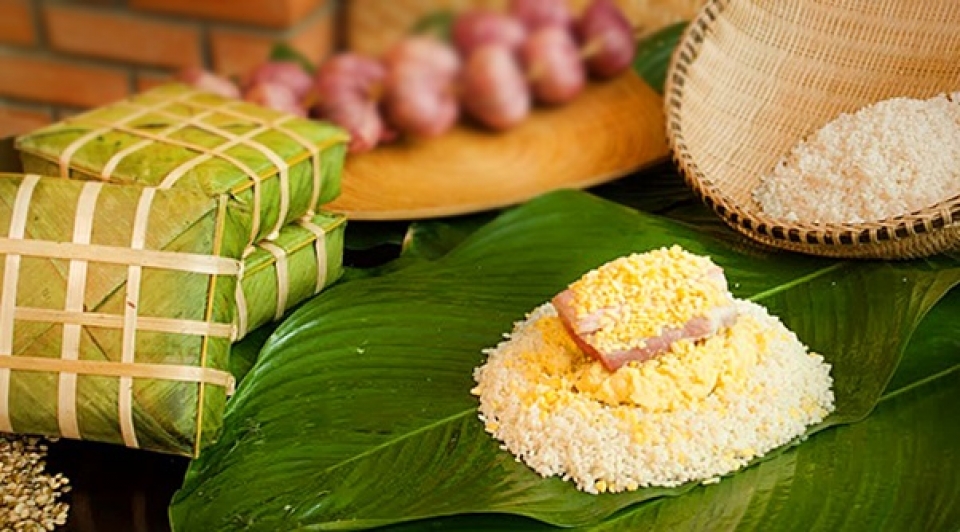 |
| Bánh chưng, the traditional Vietnamese rice cake that is eaten throughout Tet. (Photo: truyenhinhnghean.vn) |
But the adults wear a rather worried look.
Impecunious families in particular are frightened outright. Their creditors are merciless in charge in claiming their loans back before the end of the year. They send bullies who not shrink from taking away the sacred vessel on the ancestor’ altar, in which incense sticks are planted at Tet and on anniversary days, or else urinating into it failing repayment of the debts.
Even families not finding themselves in such straitened are distributed. Grandpa has a concerned look, but he can’t say what he is worried about. In fact, it is grandma who bears most of the burden of things to be done.
As early as the beginning of the 12th moon, the last month of the outgoing year, she has to go to a rural market to buy some glutinous rice at a reasonable price and a few chickens to be fattened. For a six-kilo pig, she shares the cost with a small group of neighbors. Then she has to buy some fish, a bundle of dong leaves, in which to wrap the bánh chưng.
The children are impatiently repeating their refrain: “Ma, don’t forget about my new clothes!” The mother sits up late at night, cutting and sewing, surrounded by the little ones who fall asleep at last. Her eldest daughter whispers to her sleepily: “Don’t bother making a new dress for me, mine is still serviceable.” But her mother simply says, patting her head: “Go to sleep, dear!” and goes on with her needlework.
As early in the 12th moon, grandpa has gone to buy from a Chinese shop-keeper three narcissus bulbs which are left to soak in a vessel filled with water. Then grandpa sets about making cuts in them, before putting them in water again. Next, each bulb is put in a large bowl and exposed to the sun for several days.
Meanwhile, care has to be lavished on the bulbs and the shoots which soon start sprouting. It is an art to cause the flowers to open (the word used on the occasion is: to smile) on the morning of the first day of the New Year.
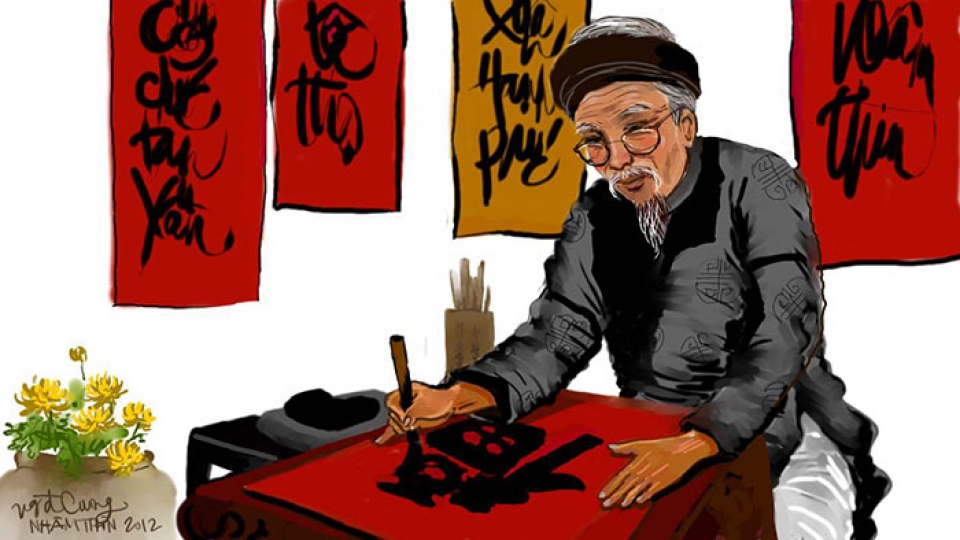 |
| Scholars use calligraphy to express good wishes for Tet. (Photo: giaoduc.net.vn) |
Another concern of grandpa’s is the purchase of a pen-brush and of some paper with a floral design for the ceremony of “opening the pen-brush” (khai bút): the scholar and the student will trace the first ideograms at the start of the new year. Grandpa will also remember to buy some red paper, on which to open couplets expressing good wishes for Tet.
If the courtyard affords enough pace, one will plant the Tet pole (Cây nêu), a bamboo pole of 5-6 meters on top of which hangs a bamboo circle from which are suspended little clay gongs, carp and “gold” ingots made from paper. On the ground, traced with slaked lime, are a set of bow and narrows with the aim of frightening away evil spirits.
When evening comes groups of poor children will stop in front of people’s closed doors and sing ritual songs, marking rhythm by tapping the ground with a bamboo cylinder containing a few coins: “Sir, if there is still light and fire in your home, please open the door.
On the upper bed, a dragon lies while on the lower one another pays tribute… You will have children as beautiful as pictures… Please give us a string of fire-crackers…” The mother will open a little window and slip a few coins into the children’s bamboo cylinder, whereupon they will immediately go away. She later distributes to her wide-eyed children new clothes taken from the family’s big box.
But the children refuse to go to bed. They will stay up until the moment of Passage to the New Year, at midnight. It is then that the whole town is shaken by the thunder of fire-crackers. The father lights incense sticks on the ancestral altar, where is laid a tray of food offerings to the manes (spirits of the dead). Later the tray is taken down and the entire family partake of the Tet meal. If the weather is fine, the parents will leave for the pagoda where they will pick a twig from a tree growing in its grounds which they believe will bring them prosperity (hái lộc).
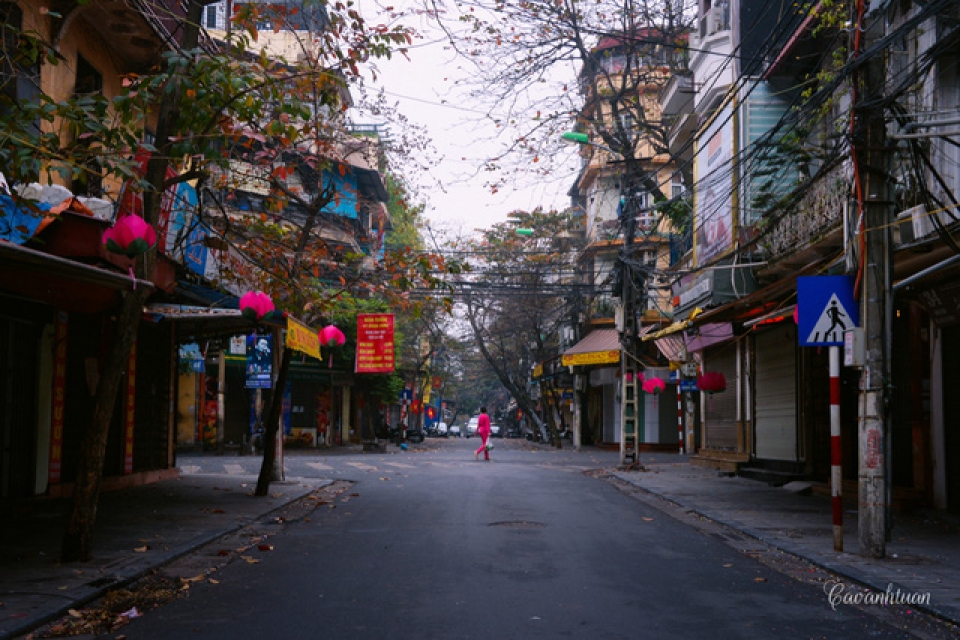 |
| First day of Tet in Ha Noi is always calm and silent. |
The following morning, the first day of the New Year, one stands in wait of the first visitor, in the hope that he will bring with him propitious portends. In many cases, arrangements are made in advance for the visit of a man favored by fate with wealth, honors, a long life and numerous descendants. Meanwhile, family members exchange best wishes among themselves.
If grandpa is living with his eldest son, father, who is the youngest, brings him the most beautiful narcissus. Mother and the children come with him. When all are about to kowtow to grandpa, he waives that ritual mark of respect, then spreads on a table a large piece of red paper with silvery spots, on which father, who is good at calligraphy, traces four ideograms: Fillial piety, Respect for one’s elder brothers and sisters, Loyalty to the country, Faithfulness. Grandma takes from her betel box shiny coins wrapped in red paper and gives those symbolic gifts to father, mother and the children. Incense sticks are lit and all prostrate themselves before the ancestral altar.
The family then pays visit to the maternal family, the children’s teachers, to the family physician, to friends and acquaintances. At each visit, much-overdrawn wishes are exchanged. For instance, to a newlywed couple one would say: “May you have a son early in the year and a daughter toward the end of it.” There are many people to visit and to receive that father and mother have to take turns: one of them by turn will be “on duty” at home. Often a visitor will stay only a few minutes, long enough to know-tow to the manes, exchange wishes with the host (or his wife), drink a cup of lotus-scented tea, taste some candied fruit or perhaps a bit of bánh chưng.
Women go to temples to consult the “oracular paper” (xin lá số). Kneeling before the altar, each will shake a vessel filled with bamboo sticks until one jumps out. The stick gives the number of the “oracular paper” whose content is to be interpreted by the soothsayer.
On the fourth day of Tet, a farewell meal is offered to the spirits of the ancestors. Paper votive offerings are burnt. Each resumes his or her normal activities after performing “opening ceremonies”: opening the shop (a trader), tracing a furrow with the plough (a farmer), applying his seal (a mandarin), penning a line of prose or poetry (a scholar or student)… In any event, the sprit of Tet is very much in the air.
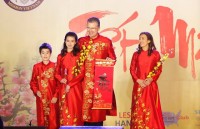 | US Ambassador, his family wear red Ao Dai to embassy Tet event US Ambassador to Vietnam Daniel J. Kritenbrink and his family dressed themselves in red Ao Dai (Vietnamese traditional dress) embroidered with yellow apricot blossom patterns ... |
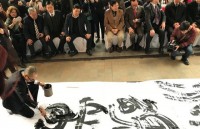 | Calligraphy exhibition opens in Ha Noi Forty one classical and avant-garde calligraphy works featuring the traditional Lunar New Year (Tet) are being showcased at the Vietnam Fine Arts Museum in Ha ... |
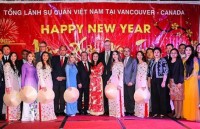 | Vietnamese in western Canada celebrate Tet holiday The Vietnamese Consulate General in Vancouver has recently held a Tet celebration for overseas Vietnamese in the western provinces of Canada. |

















